Sri Lanka 'war crimes': Main allegations
- Published

Thousands of civilians were caught in the crossfire between government forces and Tamil Tiger rebels
A thin strip of land in northern Sri Lanka was the brutal theatre of war during the closing phase of Sri Lanka's 26-year civil conflict. Thousands of civilians were hemmed in as the government battled Tamil Tiger rebels fighting for a separate homeland.
The report by a UN-appointed panel of experts focuses on alleged war crimes committed by both the Sri Lankan armed forces and Tamil Tigers during the months leading up to the defeat of the rebels in May 2009.
Numerous allegations were circulating at the time and have emerged since. During that final stage of combat very few of the accusations could be independently verified. Journalists and most aid groups were barred from the region.
Civilian deaths
In March 2009, the UN said it feared actions by both sides might amount to war crimes. The UN High Commissioner of Human Rights Navi Pillay described the level of civilian deaths, external as "truly shocking", and warned it could reach "catastrophic" levels.
The government was accused of repeatedly shelling safe zones set up to protect civilians. The rebels were accused of holding civilians as human shields and firing on those who tried to flee. Both denied the allegations.
At the time, The Times newspaper also claimed that more than 20,000 people, external had been killed in the closing stages of the conflict.
The UN estimated that up to 7,000 people had died by the end of April. The latest report now says it believes tens of thousands of civilians were killed in that final stage, adding that most civilian casualties in the final phases of the war were caused by government shelling.
Conduct of war

Civilians on a Red Cross ship are disembarked in 2009 as the conflict drew to its bloody end
Sri Lanka's government was accused of using heavy weaponry and "safe zone" , externalfor civilians.
The report claims the government shelled food distribution lines and near ICRC ships coming to pick up wounded civilians from beaches.
The government denied security forces had shelled the safe zone, saying there were a number of rebel suicide blasts in that area. The UN report is also said to condemn the rebels for killing civilians through suicide attacks.
Tamil Tiger rebels were primarily criticised for allegedly using civilians as human shields, external.
Britain and France said the rebels had been "forcefully preventing civilians from leaving" during a 48-hour ceasefire. The rebels said the truce had not been long enough to allow civilians to safely leave the conflict zone. They rejected the charge, external that rebels prevented civilians from leaving the war zone.
The report also alleges the forced recruitment of children by rebels.
Hospital shelled
The report accuses the government of "systematically" shelling hospitals on the front line. In May 2009, sources in one hospital in rebel-held territory described the artillery bombardment , external to the BBC.
At the time, the Sri Lankan government denied the army had caused civilian casualties but said it had pierced rebel defences.
After the conflict ended, a group of doctors who worked in Sri Lanka's rebel-held war zone were arrested on suspicion of collaborating with rebels., external They later retracted their accusations against the government.
Extra-judicial killings
After the war more allegations emerged. One video obtained by Britain's Channel 4 news, external purported to show the extra-judicial killing of what were thought to be Tamil rebels. Sri Lanka's army spokesman angrily rejected , externalthe video as a fabrication.
In late 2010, graphic video which apparently showed more footage from the same incident was aired by Channel 4 news. The pictures, which also showed bloodstained and blindfolded bodies, was rejected by Sri Lanka as an attempt by rebel sympathisers to tarnish Sri Lanka's image.
And one senior army commander told Channel 4 news, external that orders for the killings came from the top - Sri Lanka denied those allegations.
The UN said independent experts concluded the footage was authentic, but the government rejects this. The images cannot be verified.
A detailed Channel 4 investigation broadcast in June 2011 contained disturbing and extensive new footage showing alleged atrocities, external by Sri Lankan forces, again dismissed as fabricated.
Civilian ordeal
In the midst of the fighting, the BBC talked to civilians, external fleeing the war about their ordeal. They said they had lived under constant gunfire, intense shelling and an acute shortage of water, food and medicine.
They also confirmed accusations that the rebels were forcibly recruiting children. The head of the charity Medecins Sans Frontieres in Sri Lanka told the BBC , externalof shrapnel wounds to the limbs of civilians.
The BBC was part of a trip organised by the government to part of the recently captured front line, external, where refugees in a state of shock were listlessly standing. The army said it would work on developing the area.
The BBC has also heard numerous allegations from Tamils that their relatives are missing, among them a number of senior rebel fighters.
The government says that the military inflicted no civilian deaths during the final stages of its victory.
International human rights groups, however, say a comprehensive and independent war crimes inquiry is needed.
Sri Lanka conducted its own inquiry into war crimes but human rights groups refused to participate, saying the inquiry does not meet international standards.
Estimates say that as many as 100,000 people were killed during 26 years of war.